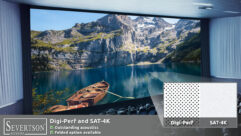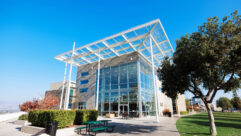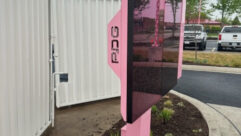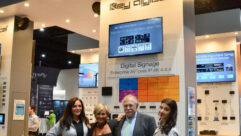the big picture: digital cinema goes boutique
Oct 1, 1999 12:00 PM,
Pete Putman
If you have been reading the newspapers this summer, you have no doubtheard about the electronic cinema screenings of An Ideal Husband and StarWars I: The Phantom Menace. What you may not have heard about is the newconcept of the boutique electronic cinema, a custom-designed small- tomid-sized theater with a high-quality surround audio system, comfortableseating and the ability to show everything from DVDs to satellitebroadcasts.
As revolutionary as digital cinema is, it will take time to implement inlarge theaters simply because of the existing motion picture production,distribution and exhibition process. Not so with boutique theaters; theirsmall size and make-it-up-as-you-go procedures for public screenings makethem logical choices to rev up large-format electronic screenings ofeverything from sporting events to first-run movies.
Because boutique theaters are independently owned and operated – at least,the first couple I have heard about – they are free to use the facility forother events well-suited to their size, such as company meetings, partiesand even videoconferences. In essence, it is a theater for hire; you supplythe attendees, and the theater provides the ambience and refreshments.
One such boutique digital cinema is already up and running in downtownSeattle. The Big Picture, a 3,800 ft2 (353 m2) facility with antique bar,assorted living rooms and cozy nooks, and an 88-seat theater, has beenbooking private meetings and holding public screenings of second-run filmsjust before those films are released to the public on videocassette or DVD.
The Big Picture is the brainchild of Mark and Katie Stern, long experiencedin the ways of feature film booking and screenings. Mark booked films forthe Wilmette Theater in Chicago for more than 20 years, but he decided tobranch out into e-cinema after attending last year’s INFOCOMM and theProjection Shoot-Out in Dallas where he saw more than a few high-brightnessLCD and DLP projection systems suitable for the boutique theater concept.
The theater at Big Picture measures 359 infinity 509 (11 m infinity 15 m)and uses an Electro-home VistaGRAPHX 4000 DLP projector for everything fromPowerpoint presentations to video. The VG 4000 uses three 1,024 infinity768 DMDs and a xenon lamp source (important for cinema projection) andthrows an image 50 feet (15m) to a 109 infinity 209 (3 m infinity 6 m)Stewart Flexible MicroPerf front screen. Program sources include a Toshiba3109 dual-disc DVD player, Panasonic A310 single-disc DVD deck, and a JVCHR-S3500u S-VHS tuner/VCR/VHS player for feeds from cable and playing VHStapes. Direct TV is also piped into the system, and there is even a SegaDreamCast gaming console.
A B&K Components Reference 20 A-V controller performs all of the A-Vswitching. The audio system consists of a surround sound processor feedingRane parametric EQs for the left, center and right channels plus discreterear channels. Tannoy TX-2 and TX-3 controller/crossover systems then drivea quad stack of QSC 2400 power amps. The loudspeaker complement consists ofthree Tannoy T300 loudspeakers with dual 12 inch (305 mm) concentricdrivers, while surrounds are handled by Tannoy i-12 loudspeakers – twopairs on either side of the theater and another pair on the rear wall.Finally, another pair of Tannoy B-950 dual 18 inch (457 mm) subwoofers makeup a dedicated ELF (effects low frequency) channel with a single 18 inchTannoy B-475 subwoofer on the center channel for extended bass.
I toured the theater in late July of 1999, dropping in one day to grab afew photos and stopping by several nights later to attend a scheduledshowing of Rushmore. This screening from DVD (licensed for publicexhibition) used the VistaGRAPHX’s internal video scaling circuitry, butthe aspect ratio was not set up correctly – the image I viewed was too longand narrow. This turned out to be a case of the wrong image set-up memorybutton being selected on the Electrohome projector.
In any case, image quality was quite good – brightness and contrast were upto the usual standards from a three-DMD engine with a xenon lamp. I didnotice scaling and line multiplying artifacts in the presentation, both ofwhich can be easily eliminated by an outboard video scalar along the linesof Folsom’s VFC-series, RGB Spectrum’s VLI200 or Faroudja’s DVP-3000. BigPicture’s technical director Spain McMillen was checking out these modelsafter my visit.
The surround audio system is quite powerful, but during the course of thefilm, we became aware of an exaggerated amount of bass boost. Rushmore isnot a summer blockbuster SFX movie, just a pleasant, quirky comedy about aboy’s private school with lots of dialogue and music, but little specialeffects. This led to a rather spirited discussion between Stern and myfriend Ted Bardusch, a Seattle-based Windows NT software developer who hasmany years of experience in audio design for broadcast and studios.
According to Stern, audiences want lots of low-end response and thump intheir movies for a more exhilarating cinema experience. Bardusch disagreed,and he felt quite strongly that excessive low-end response actuallydegrades the listening experience. The point here was not to declare awinner of this technical debate. What is more important is that payingcustomers could even have such a conversation with a theater owner in thefirst place, and that the owner would even be willing to listen andpossibly implement changes to the system. Try that at your local multiplextheater.
Although Big Picture is probably the first such company to launch aboutique digital cinema, they will not be the last. This concept has beenfloating around some of the major trade shows for some time, and I havediscussed it with more than one projector manufacturer at INFOCOMM andCEDIA. Indeed, Stern has plans to franchise Big Pictures in major citiesand to market aggressively to business, educational and institutional users.
The size of this theater is probably representative of many mid-sizedscreening rooms and classrooms. Until the past couple of years, the onlyoption for projecting high-brightness, high-resolution images was to bringin a big (more than 150 pounds or 67.5 kg) projection chassis with xenon ormetal-halide lamps. The introduction of products like the VistaGRAPHX 4000(since upgraded to 5,000 lumens) and NEC’s new MultiSync XT5000installation DLP projector, however, have made the boutique cinema conceptmore attractive.
Size and weight are two big considerations when designing and building sucha room, and both of these projectors have footprints comparable to smallthree-gun CRT projectors. That means a comparatively easy install andsimpler maintenance for the customer, but plenty of screen illumination anda simple, single-lens solution.
On the LCD side, three new products are available for boutique digitalcinemas, and they all have SXGA 1,280 infinity 1,024 resolution to boot.Sanyo’s 37 pound (17 kg) PLC-EF10N (also sold by Proxima) can crank outmore than 2,500 lumens and supports composite, Y/C, component YUV and evenY/Pb/Pr or RGsB HDTV. Barco’s BarcoReality 6300 DLC tips the scales around60 pounds (27 kg) and produces slightly more illumination with comparableinput compatibility, while Sony’s quad-lamped VPL-FE100 produces more than3,000 lumens and is just as versatile in supporting all video and HDTVsignals.
Like the VistaGRAPHX 4000 showed, however, an external video scalar isprobably a good idea with any flat-matrix projector to get a cinema-likeimage, particularly if you want to tweak up and save more than one presetaspect ratio for screenings. The LCD projectors currently have oneadvantage over the Electrohome and NEC offerings – the ability to show1,280 infinity 720p broadcasts at full resolution with no letterboxing.
Currently, Stern has plans to include over-the-air HD broadcasts as well asspecial satellite broadcasts of boxing and football in the programming mix.With 88 plush seats (no more than four in any row for easy access) plus cupholders and ottomans for the front row, Big Picture has hosted some uniquemeetings for Boeing, MTV, Microsoft and the Screen Actor’s Guild. (Thetheater expands to 100 attendees for a meeting.) If you would like to findout more, check out www.thebigpicture.net for a more detailed descriptionof the theater’s amenities, including a leopard-print upholstered couch inthe living room.










